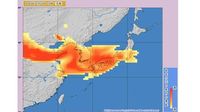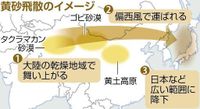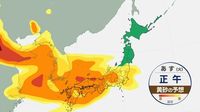The Japan Meteorological Agency (JMA) has issued a forecast indicating that yellow sand, known as kosa, will sweep across a broad swath of Japan from March 25 to March 26, 2025. This weather event, which originates from the Asian continent, is expected to significantly impact visibility and public health.
The agency warns that visibility is anticipated to drop below 10 kilometers in many areas, while in some regions, it may fall to under 5 kilometers. Such conditions can pose risks not only on the roads but also affect daily activities and overall health.
The impacted regions span from Tohoku in the north down to Kyushu in the south, including major areas such as China, Shikoku, Kinki, Chubu, and Kanto. The JMA, in its latest advisory, noted that, "The Japan Meteorological Agency is calling for people to pay attention to the impact on traffic," urging citizens to exercise caution while traveling.
On March 25, heavy concentrations of yellow sand are predicted, making it vital for residents to prepare for the repercussions. The agency elaborated that people should monitor how this phenomenon might affect laundry, respiratory health, and outdoor activities. Specifically, they stated, "Please be careful about the impact on laundry and your physical condition on March 25 and March 26." This warning serves as a crucial reminder in the face of potential health risks posed by particulate matter.
As yellow sand clouds sweep across the landscape, the jagged contours of Japan's terrain may fade into the amber haze, obscuring vision and enveloping towns in a dusty film. The forecasted events are reminders of the interconnectedness of climate and health; as the winds whip across borders, they carry more than dust— they transport allergens and harmful particles that can exacerbate existing health problems.
For those who suffer from allergies or respiratory conditions, the onset of kosa can be particularly troublesome. The JMA’s guidelines are therefore not just a matter of environmental caution—they are directives aimed at safeguarding the community's health. Residents are advised to stay indoors when possible, close windows, and wear masks if they must go out during the peak of the yellow sand storm.
As history has shown, past occurrences of yellow sand have brought challenges not only in terms of visibility but also in increased medical consultations for respiratory issues. Schools and businesses are preparing for potential disruptions as the yellow dust makes its presence felt across regions.
With the forecast indicating that conditions could fluctuate swiftly, the public's preparedness is essential. Motorists are urged to drive with extra caution; low visibility conditions can lead to accidents on the roads if proper measures are not adhered to. As the situation develops, the JMA will continue to provide updates and information through its channels, ensuring that the public stays informed and aware of the latest predictions.
In summary, as the yellow sand approaches, communities from Tohoku to Kyushu should take heed of the Japan Meteorological Agency's warnings. Being proactive can help mitigate the potential effects of this weather phenomenon and ensure safety during challenging conditions. Awareness, preparedness, and caution are the keys to navigating the impacts of yellow sand that will soon sweep across the nation.






